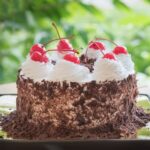A naked cake is a charming and rustic dessert option that has gained tremendous popularity in recent years. Unlike traditional cakes that are fully frosted, a naked cake is left with its layers exposed, giving it a natural and organic appearance. Despite its seemingly simple design, decorating a naked cake requires skill and technique to achieve a beautiful and delicious result.
Naked cakes have become the go-to choice for many celebrations because of their versatile nature. Whether it’s a wedding, birthday party, or any special occasion, these cakes effortlessly blend in with any theme or decor. The rustic appeal of a naked cake lends an elegant yet relaxed atmosphere to any event, making it the perfect centerpiece.
If you’re keen on trying your hand at decorating a naked cake, there are certain essential tools and ingredients that you’ll need to have in your arsenal. From cake layers to fillings, frosting to decorating tools, each element plays a crucial role in creating the perfect naked cake. With the right combination of flavors and textures, along with some creative decorating techniques, you can transform an ordinary dessert into something truly extraordinary.
In this article, we will guide you through every step of the process – from leveling and stacking your cake layers to achieving a flawlessly smooth crumb coat. We will delve into different flavor combinations and explore various fillings that can elevate your naked cake to new heights. Additionally, we will provide you with a range of creative decorating ideas and finishing touches that will make your creation truly stand out.
So if you’re ready to embark on a journey of culinary artistry and create your very own masterpiece, let’s dive into the world of decorating naked cakes together. By the end of this article, not only will you have learned valuable techniques but also gained confidence in your ability to design beautiful and delectable naked cakes for any occasion.
Essential Tools and Ingredients
Cake Layers
One of the essential components of decorating a naked cake is having the right cake layers. For a naked cake, it is generally recommended to use three or more layers to create an impressive height and showcase the different fillings and frostings. When choosing your cake layers, opt for flavors that complement each other and will pair well with your chosen fillings.
Popular options include vanilla, chocolate, red velvet, lemon, and carrot cake. You can either bake the layers yourself or purchase pre-made ones from a bakery or grocery store.
Filling
To add flavor and moisture to your naked cake, you’ll need a delicious filling. There are a variety of options to choose from, depending on your taste preferences. Traditional choices like buttercream frosting or cream cheese icing work well for classic flavors such as vanilla or chocolate cakes.
If you’re looking for something more adventurous, consider using fruit preserves to add a burst of fruity flavor or ganache for a rich and decadent filling. It’s important to ensure that your chosen filling complements the flavors of both the cake layers and frosting.
Frosting
When it comes to frosting a naked cake, less is more. The goal is to achieve a rustic and natural look by allowing some of the cake layers to peek through. Swiss meringue buttercream is often used for its smooth texture and ability to hold up well in warmer temperatures.
However, cream cheese frosting can also be a great option if you’re going for a tangy flavor profile. Whichever type of frosting you choose, make sure it has a good consistency for spreading onto the layers without causing them to collapse.
Decorating Tools
To successfully decorate your naked cake, there are several tools you’ll need on hand. A serrated knife or cake leveler will be essential for leveling your cake layers to create an even surface for stacking. A turntable is a helpful tool for rotating your cake while frosting and decorating, allowing for smooth and even application.
An offset spatula is ideal for spreading the frosting smoothly and creating texture on the sides of the cake. Additionally, having piping bags, various tips, and a cake stand or platter will make the decorating process easier and more efficient.
By ensuring you have all the necessary tools and ingredients, you’ll be well-equipped to decorate a stunning naked cake that not only looks beautiful but also tastes delicious. Remember to gather all the components beforehand so that you can focus on creating a visually appealing masterpiece without any interruptions or last-minute trips to the store.
Choosing the Right Flavor Combinations
When it comes to decorating a naked cake, choosing the right flavor combinations is crucial in creating a truly delectable and memorable experience for your taste buds. While the rustic appearance of a naked cake may seem simple, the flavors within can be complex and exciting. In this section, we will explore some tips and ideas to help you create delicious flavor pairings for your naked cake.
Classic Combinations
Classic flavor combinations are always a safe bet when it comes to creating a crowd-pleasing naked cake. Some classic pairings include chocolate and vanilla, lemon and raspberry, or carrot and cream cheese. These combinations have stood the test of time because they work harmoniously together and offer a familiar yet delicious experience. Don’t be afraid to experiment with different ratios of flavors within these classic combinations to find your perfect balance.
Unique Twists
If you’re looking to add your own personal touch to your naked cake, consider experimenting with unique twists on traditional flavor pairings or exploring unusual combinations. For example, pairing lavender with lemon or adding a hint of rosemary to a chocolate cake can create unexpected and delightful flavors. Consider incorporating seasonal fruits like mango or passionfruit for an exotic twist, or play around with different spices such as cardamom or cinnamon for warmth and depth.
Balancing Sweetness
When choosing flavor combinations for your naked cake, it’s important to consider the overall sweetness level. This ensures that one component doesn’t overpower another and that each bite is well-balanced. If you have a very sweet frosting, consider pairing it with a slightly tart filling or vice versa. Additionally, incorporating contrasting textures like crunchy nuts or creamy ganache can add complexity to the overall flavor profile.
Remember that experimentation is key when it comes to creating unique flavor combinations for your naked cake. Don’t hesitate to think outside the box and try new combinations that excite your palate. With the right flavors, your naked cake will not only be visually stunning but also a true delight to indulge in.
Leveling and Stacking
Leveling and stacking your cake layers is a crucial step in creating a stable base for decorating your naked cake. By ensuring that your layers are level and securely stacked, you will be able to achieve a visually appealing and structurally sound cake. Follow these step-by-step instructions to level and stack your cake layers like a pro.
First, allow your cake layers to cool completely before attempting to level or stack them. This ensures that the cakes have set properly and will withstand the leveling and stacking process without crumbling or falling apart.
To level your cake layers, start by using a long serrated knife or a cake leveler. Carefully hold the knife horizontally and gently saw through the domed top of each layer, removing any excess cake until the surface is flat and even.
After leveling each layer, it’s time to prepare them for stacking. Start with the bottom layer of your naked cake, placing it on a sturdy surface or serving plate. Spread a generous amount of filling evenly over the top of this first layer. It can be fruit preserves, ganache, flavored buttercream, or any other filling of your choice.
Next, carefully place the second layer on top of the first layer with filling. Make sure to align the edges of both layers as closely as possible. Gently press down on the second layer to secure it in place. Repeat this process if you have more than two layers.
To create an even height throughout your naked cake’s appearance, ensure that all the layers are stacked directly above one another with no offsetting sides. Use a spatula or an icing smoother to gently push down on each stacked layer after adding them to ensure they are aligned perfectly.
By following these step-by-step instructions for leveling and stacking your cake layers, you will have a sturdy foundation for decorating your naked cake. With a flat and even base, you can move on to the next steps of crumb coating and creative decorating techniques to create a stunning centerpiece for your celebration.
Crumb Coating
A crumb coating is a crucial step in decorating a naked cake as it helps to achieve a smooth and flawless finish on the cake. Without this coating, the crumbs from the cake layers can mix with the frosting, resulting in an uneven and messy appearance. By applying a thin layer of frosting or buttercream to seal in the crumbs, you create a clean canvas for the final layer of frosting or decoration.
To achieve a successful crumb coating, start by leveling your cake layers using a knife or cake leveler to remove any domes or uneven surfaces. This ensures that your layers fit together neatly and provide a stable base for decorating. Once leveled, place one layer on your desired serving plate or cardboard round.
Next, spread a thin layer of frosting or buttercream over the top of the first layer using an offset spatula. Make sure to cover the entire surface evenly, spreading it right to the edges and corners. This will help hold the crumbs in place.
After applying the first layer of frosting, carefully place another cake layer on top and repeat the process until all layers are stacked. Ensure each layer is centered and aligned properly before adding more frosting.
Once all layers are stacked, apply another thin layer of frosting around the sides and top of the cake using long strokes with your offset spatula. Be sure to smooth out any excess frosting as you go along. The goal is not to fully frost the cake at this stage but rather create a foundation that seals in any loose crumbs.
After applying the crumb coat, refrigerate your cake for about 10-15 minutes to allow it to firm up before proceeding with adding the final layer of frosting or decorations.
| Tools | Ingredients |
|---|---|
| – Offset spatula | – Cake layers |
| – Cake leveler or knife | – Filling |
| – Refrigerator | – Frosting or buttercream |
Alternate Fillings
When it comes to decorating a naked cake, the filling is just as important as the cake layers themselves. Adding a delicious filling not only enhances the flavor of the cake but also adds moisture and texture to each bite. There are plenty of options for fillings that will take your naked cake to the next level. Here are some ideas to consider:
- Fruit Preserves: Using fruit preserves as a filling can add a burst of fruity freshness to your naked cake. Choose from classic flavors like strawberry, raspberry, or peach, or get creative with unique combinations like blueberry-lavender or pineapple-mango. Spread a generous layer of preserves between each cake layer and let the natural sweetness elevate your creation.
- Ganache: If you’re looking for something rich and decadent, ganache is the way to go. Made from a mixture of chocolate and cream, ganache creates a smooth and velvety filling that pairs well with any type of cake. Dark chocolate ganache offers an intense cocoa flavor, while white chocolate ganache adds a creamy sweetness. Consider adding additional flavors by infusing the ganache with coffee, citrus zest, or liqueurs.
- Flavored Buttercream: Buttercream frosting is a classic choice for decorating cakes, but why not take it up a notch by adding different flavors? Experiment with infused buttercream fillings such as vanilla bean, almond, coconut, or even lavender. You can also incorporate natural extracts like mint or lemon for refreshing taste profiles. The possibilities are endless when it comes to customizing your buttercream filling.
When selecting your filling ingredients, ensure that they complement the overall flavor profile of your naked cake. Consider incorporating contrasting or complementary flavors that will create an exciting and harmonious taste experience for your guests. Don’t be afraid to get creative and try new combinations to personalize your naked cake and make it truly unique.
Creative Decorating Techniques
When it comes to decorating a naked cake, the possibilities are endless. The minimalist style of a naked cake allows for a variety of creative and visually striking decorating techniques. Whether you prefer a rustic look or a more elegant design, there are many ways to add that wow factor to your naked cake. Here are some inspiring ideas:
- Fresh Flowers: Adding fresh flowers to your naked cake is a simple yet beautiful way to enhance its appearance. Choose flowers that match the color scheme or theme of your celebration. Popular choices include roses, peonies, and edible flowers like pansies or violets. Make sure to use organic flowers that have not been treated with chemicals.
- Fruits: Incorporating fresh fruits onto your naked cake can bring vibrant colors and delicious flavors. Consider using seasonal fruits such as berries, sliced citrus fruits, or even tropical fruits like kiwi or pineapple. Place them strategically on top of the cake or create cascades of fruit along the layers for an eye-catching effect.
- Chocolate Drizzles: Drizzling melted chocolate over the top of your naked cake can add a touch of decadence and richness. Use high-quality chocolate in white, dark, or milk varieties and let it cool slightly before drizzling it over the cake with a spoon or piping bag. You can also experiment with different patterns like zigzags or swirls.
- Intricate Piping Designs: If you want to take your decorating skills up a notch, try piping intricate designs onto your naked cake using buttercream frosting. Use different piping tips to create rosettes, borders, lace-like patterns, or even personalized messages on the sides of the cake. This technique requires some practice but can result in stunningly detailed cakes.
Remember that while decorating your naked cake, the goal is to enhance its natural beauty rather than completely covering it up. These creative techniques are meant to highlight the layers and fillings, so keep that in mind when choosing your decorations. Experiment with different combinations and let your imagination run wild to create a personalized and visually striking naked cake for any celebration.
Finishing Touches
Once you’ve mastered the art of leveling, stacking, and crumb coating your naked cake, it’s time to move on to the exciting part – adding the finishing touches. These final touches will elevate your naked cake from beautiful to breathtaking, making it the center of attention at any celebration. In this section, we will explore various tips and tricks to help you add those special details that will make your naked cake truly stand out.
One simple yet effective way to enhance the appearance of your naked cake is by dusting it with powdered sugar. This delicate touch adds a touch of elegance and provides a beautiful contrast against the exposed layers of cake and frosting.
Using a sieve or a fine-mesh strainer, gently sprinkle powdered sugar onto the top of your cake until you achieve your desired effect. You can also use stencils to create intricate designs with the powdered sugar for a more personalized touch.
If you want to take your naked cake to the next level, consider incorporating edible glitter into your design. Edible glitter adds a touch of sparkle and glamour that is perfect for special occasions like weddings or birthdays.
To apply edible glitter, simply sprinkle it onto your already-frosted cake by using either clean hands or a small spoon. Be sure to do this step over a large piece of parchment paper or a rimmed baking sheet to catch any excess glitter that doesn’t adhere.
Lastly, don’t forget about using edible decorations to add an extra element of creativity and charm to your naked cake. Fresh flowers are a popular choice as they bring natural beauty and vibrant colors to any dessert. Make sure you choose flowers that are safe for consumption and properly wash them before placing them on top of your cake.
You can also consider using fruits such as berries or slices of citrus fruits as decorative elements. Simply arrange them strategically on top or around your cake for an eye-catching display.
By following these tips and tricks, you can add the final touches to create a stunning naked cake that will impress your guests. Remember, the finishing touches not only enhance the visual appeal of your cake but also provide an opportunity to add unique flavors and textures. So, don’t be afraid to get creative and experiment with different ideas to make your naked cake truly unforgettable.
Troubleshooting and Common Mistakes
Decorating a naked cake may seem like a straightforward process, but like any other baking project, there are common challenges that can arise. Knowing how to troubleshoot these issues can ensure that your finished product turns out beautifully. One common issue that people face while decorating naked cakes is cake sliding. This occurs when the cake layers start to shift or slide off one another during the stacking process.
To prevent cake sliding, it is crucial to properly level your cake layers. Use a serrated knife or cake leveler to trim off any domed tops, ensuring that each layer is completely flat. Additionally, make sure that your filling and frosting act as a “glue” holding the layers together.
Spread an even layer of filling on top of each layer before stacking them. Once stacked, use a spatula to apply an even layer of frosting around the sides to secure the layers in place.
Another common mistake when decorating a naked cake is achieving uneven frosting. This can happen when the consistency of the frosting is too thick or too thin. To avoid this issue, make sure your frosting has reached a spreadable consistency before applying it to the cake.
If it is too thick, add a small amount of milk or cream to loosen it up. On the other hand, if it is too thin, add more powdered sugar until you achieve your desired consistency.
Collapsing layers can also be a frustrating problem while decorating naked cakes. This typically happens when the cake layers are not sturdy enough or have not been properly supported with dowels or straws if making a multi-tiered cake. To avoid collapsing layers, consider using firm cake recipes such as pound cake or adding supports between tiers for stability.
By being aware of these common mistakes and having solutions at hand, you can confidently troubleshoot any issues that arise while decorating a naked cake. Remember, practice makes perfect, so keep experimenting and learn from your mistakes to create the most beautiful naked cakes possible.
Conclusion
In conclusion, decorating a naked cake can be a fun and creative experience that allows you to showcase your personal style and taste. Throughout this article, we have discussed the essential tools and ingredients needed for successful decoration, as well as tips for choosing the right flavor combinations. We have also explored step-by-step instructions on leveling and stacking the cake layers, achieving a smooth crumb coat, and experimenting with alternate fillings.
Additionally, we have provided various creative decorating techniques such as using fresh flowers, fruits, chocolate drizzles, or intricate piping designs. Remember that the finishing touches are crucial to elevate the overall look of your naked cake, whether it’s dusting with powdered sugar or adding edible decorations.
While there may be some common challenges along the way, such as cake sliding or uneven frosting, do not get discouraged. Troubleshooting these issues is all part of the learning process. With practice and patience, you will improve your skills and create stunning naked cakes that are both beautiful in appearance and delectable in taste.
So why not give it a try? Experiment with different flavors, decorations, and techniques to truly make your naked cake unique. Whether it’s for a birthday celebration or a special gathering with loved ones, a naked cake is sure to impress everyone who sees and tastes it. So dust off your baking tools and let your creativity soar as you embark on the journey of decorating your own beautiful and delectable naked cakes.
Frequently Asked Questions
How do you make a plain cake look nice?
To make a plain cake look nice, there are several simple techniques that can be employed. One way is to create an even and smooth surface by using a spatula or icing smoother to spread a thin layer of frosting all over the cake. This provides a clean canvas for decoration.
Next, consider adding some texture or dimension to the cake by using piping techniques, such as creating rosettes, swirls, or dots with colored frosting. These small decorations can add visual interest and make the cake look more elegant. Lastly, adding edible toppings like fresh fruit slices, sprinkles, or even edible flowers can enhance the overall appearance of the cake and give it a pop of color.
How to decorate plain cake?
Decorating a plain cake offers endless possibilities for creativity and personal touch. Start by selecting a suitable frosting that complements the flavor of the cake and your desired design. Ensure your frosting is smooth and easy to work with by whipping it properly.
When it comes to decorating, you can use various tools such as piping bags fitted with different tips to pipe different patterns onto the cake’s surface. Consider making borders around the edges or writing messages on top using contrasting colored frosting. Another option is fondant icing; you can roll it out and drape it over the entire cake to create a smooth canvas for additional decorations like fondant cutouts or molded figurines.
How do you make a sheet cake look pretty?
Making a sheet cake look pretty involves specific strategies aimed at maximizing its visual appeal despite its larger size and flatter shape. Begin by giving attention to the overall presentation of the cake: ensure that its edges are straight and levelled off if necessary so that it appears neat and professional. Utilize frosting techniques such as spreading an even layer of buttercream or whipped cream over the top and sides of the sheet cake until it is nicely covered in an array of colors if desired; consider textured designs like swirls or ruffles for added depth.
Alternatively, utilize decorative elements such as piped patterns, edible sprinkles, or chocolate shavings to add color and visual interest. Finally, don’t hesitate to embellish the cake further by using fresh fruits, colorful berries, or even edible flowers arranged beautifully on the surface. This will not only make the cake look visually appealing but also add a touch of freshness and elegance.

Welcome to my blog about home and family. This blog is a place where I will share my thoughts, ideas, and experiences related to these important topics. I am a stay-at-home mom with two young children. I hope you enjoy reading it! and may find some helpful tips and ideas that will make your home and family life even better!





